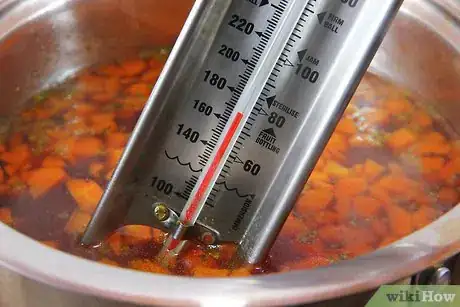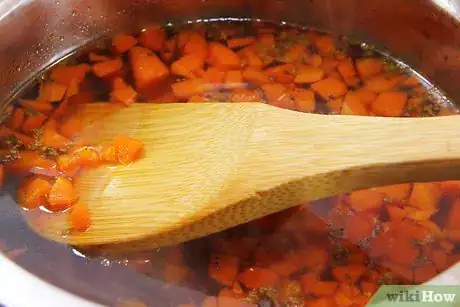This article was co-authored by wikiHow Staff. Our trained team of editors and researchers validate articles for accuracy and comprehensiveness. wikiHow's Content Management Team carefully monitors the work from our editorial staff to ensure that each article is backed by trusted research and meets our high quality standards.
This article has been viewed 69,965 times.
Learn more...
If you’re looking for a quick and easy meal, soup is a great choice because you can cook it now and save leftovers in the freezer. Lentil or vegetable soup are commonly frozen and reheated. These soups taste great and they’re really easy to defrost because it takes little time and equipment. There are many methods to do this, like putting the frozen soup in the refrigerator overnight. But if you’re in a hurry defrosting in the microwave or on the stove may be the answer.
Steps
Using a Microwave
-
1Take the soup out of the freezer and put it into a microwave-safe bowl. Turn the bowl upside down and look for a label that should say “Microwave-safe” or “Heatproof”. If the soup is already in a microwave-safe bowl, then remove the lid and cover the container with a plastic wrap that is also microwave safe.[1]
- Glass and ceramic bowls are usually microwave-safe.
- Never put metal or aluminum bowls or dishes in the microwave.
- You can use wax or parchment paper instead of plastic wrap.
-
2Place the container in the microwave and heat on a medium-low setting. Microwave the soup on 30% power for about 3 to 5 minutes. Remove the container, stir the soup and continue microwaving until the ice is melted and the soup is hot.
- To adjust the power level, enter the cook time first and then press the “Power” button. The reduced power will allow your soup to defrost evenly.
- If you are heating with glass or ceramic, the container may be hot. Use an oven mitt or heat-resistant glove to remove from the microwave.
Advertisement -
3Use a food thermometer to test the temperature of the soup. Remove the container from the microwave. Place a food thermometer into the soup and check that the temperature is 165 °F (74 °C) to make sure that it is safe to eat.
- Don't make contact with the bottom or sides of the bowl, this will give an incorrect temperature reading.
- If you don't have a thermometer on hand, you can use a knife. Insert the knife into the center of the bowl. The soup is warm enough to eat when the knife is hot when removed.
Defrosting on a Stove
-
1Place the container in a kitchen sink and fill the sink with warm water. Put the container into the sink and let it sit for 5 to 10 minutes or until the ice starts to melt. The soup is warm when it starts to separate from the sides of the container.[2]
- Soup stored in a glass may need extra time to defrost to make it easier to remove.
- If stored in a bag, let the soup sit in the sink until you can squeeze the bag and the soup breaks into pieces.
-
2Remove the container from the sink and pour the soup into a pot. Find a pot that is big enough to hold the soup and 1 cup of extra water. Place the pot on the stove and add ¼ cup of warm water. Stir the water into the soup.
- It’s best to add water to the pot because soup absorbs water when it’s frozen.
- This is also a great time to add additional seasonings to give the soup a fresh flavor. Try adding a little lemon juice, a pinch of salt, and fresh herbs.[3]
-
3Heat the soup on the stove and stir often. Cover the pot with a heat-resistant lid and warm the soup on medium-low heat. Stir every 30 seconds to keep the soup from burning.
- A thick-bottomed pot works best for heating soup because it evenly distributes heat.
- If you happen to burn the soup, do not scrape the bottom. Instead, pour the soup into a different pot and reheat.
Warnings
- Avoid microwaving soup in plastic containers. When heated, plastic can leak harmful chemicals into your food.[4]⧼thumbs_response⧽
- Make sure that the frozen soup is in a leak-proof bag or plastic container before placing in warm water. Leaks and holes can cause harmful bacteria to grow and make the soup unsafe to eat.⧼thumbs_response⧽
References
- ↑ https://www.goodhousekeeping.com/food-recipes/cooking/tips/a17357/thawing-reheating-frozen-food/
- ↑ https://www.goodhousekeeping.com/food-recipes/cooking/tips/a17357/thawing-reheating-frozen-food/
- ↑ https://food52.com/blog/17895-our-every-question-on-freezing-thawing-soup-answered
- ↑ https://food52.com/blog/17895-our-every-question-on-freezing-thawing-soup-answered

























































